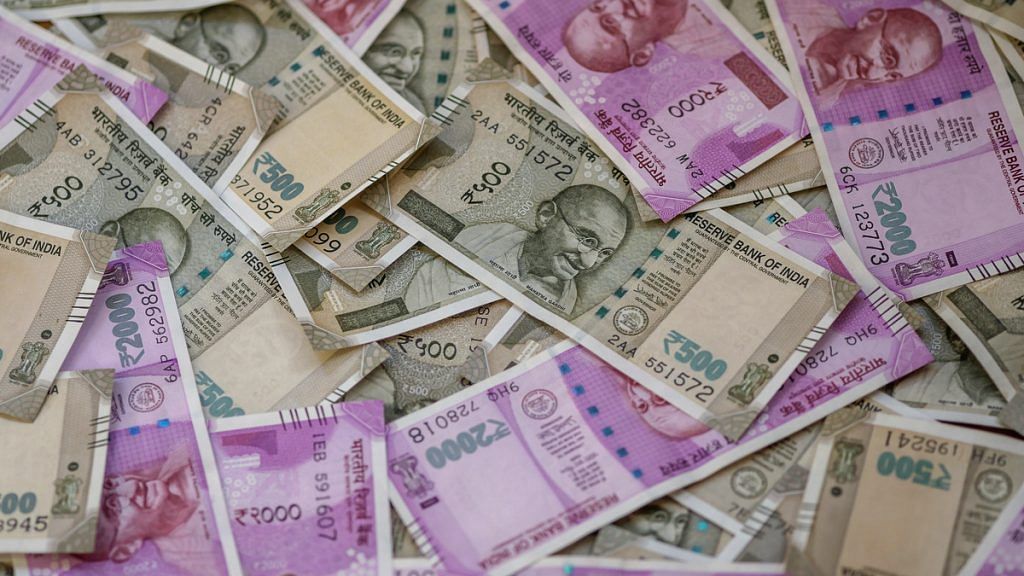New Delhi: The total net tax collected in the first half of 2019-20 is only 36.8 per cent of the budgeted number for the full year — the lowest levels seen since 2014-15.
This is in an indication that the slowing economy is adversely impacting government revenues.
Data released by the Controller General of Accounts Thursday showed that the total net tax collections for the six months ending 30 September was Rs 6.07 lakh crore, with the full-year target being Rs 16.49 lakh crore.
The corresponding figures for the same period in preceding years were 39.4 per cent in 2018-19, 44.2 per cent in 2017-18, 42.5 per cent in 2016-17, 40.2 per cent in 2015-16 and 33.1 per cent in 2014-15.
The slowdown in tax collection could mean that the Narendra Modi government could face a major challenge in reining in the fiscal deficit to 3.3 per cent of the gross domestic product in the current fiscal.
India’s economy grew at a six-year low of 5 per cent in the April-June quarter. Economists expect only a marginal revival going forward, forcing the Reserve Bank of India and other multilateral institutions to revise India’s full-year growth estimates downwards to around 6 per cent.
Fall in direct & indirect tax collections
Data shows that both direct and indirect tax collections are much below targets, though the shortfall in the direct tax figure is starker.
Corporate tax collections stand at Rs 2.49 lakh crore, less than one-third of the full-year target of Rs 7.66 lakh crore. The shortfall is likely to be greater if some companies opt for a lower effective tax rate of 25 per cent, which was announced by Finance Minister Nirmala Sitharaman last month.
Personal Income Tax collections so far are slightly more than one-third of the budgeted targets — Rs 2.13 lakh crore against Rs 5.69 lakh crore, respectively.
The central goods and services tax collection total is Rs 2.47 lakh crore, as against the full-year target of Rs 5.26 lakh crore.
Data released by the CGA also shows that expenditure utilisation has remained the same as the first six months of the previous year — 53.4 per cent of the full-year target of Rs 27.86 lakh crore.
Despite the tepid growth in tax collections and constant expenditure, the fiscal deficit in the first half was at 92.6 per cent of the full-year target, marginally better than the levels seen last year, thanks to a sharp surge in dividends and profits.
Non-tax revenues are at 66.7 per cent of the budgeted targets, as against 44.5 per cent in the year-ago period. The government received Rs 1.55 lakh crore of dividends and profits in the first half of the year, as against a full-year target of Rs 1.63 lakh crore.
The government is likely to rely heavily on non-tax revenues going forward, including revenue from sale of its stakes in state-owned firms like Air India and Bharat Petroleum Corporation, and a Rs 1.76 lakh crore pay-out from the RBI.
Also read: Govt unlikely to cut personal income tax rates for rich
‘Worrisome’ numbers
Devendra Pant, chief economist at India Ratings and Research, pointed out that the fiscal deficit trend is a “bit worrisome”, and the government is likely to overshoot the full-year fiscal deficit target of 3.3 per cent of the GDP.
“Had there not been one time windfall gain from the RBI, the fiscal deficit would have looked much worse,” Pant said.
He said the “dismal performance” of tax revenues is a worrying trend, and that on a quarterly basis, net tax revenue growth declined to 3.0 per cent in the July-September quarter from 6 per cent in the April-June quarter.
From October, net tax revenue has to grow 42 per cent to achieve the FY20 budget target of Rs 16.5 lakh crore, which appears to be a daunting task, Pant said.
He also pointed out that the government has accelerated expenditure in the July-September quarter, which will support economic growth hit by demand slowdown, and in turn, improve tax collections.
Also read: Modi govt is widening India’s fiscal deficit by pumping money into ailing PSUs
